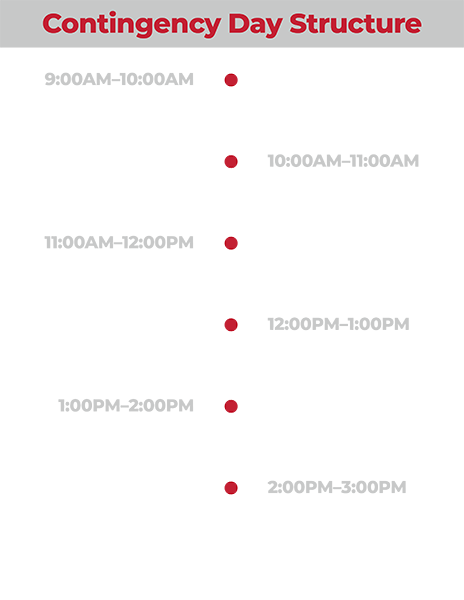A COMMITMENT TO EDUCATIONAL QUALITY REGARDLESS OF CIRCUMSTANCES
The MACS Flexible Instructional Days Plan (FID) is a comprehensive framework for maintaining educational continuity during emergencies through multi-tiered communication, equitable access, and clear accountability measures.

Multi-Tiered Communication Protocol
When Flexible Instructional Days (FID) are instituted due to inclement weather, building issues, or qualifying emergencies, our school follows a clear communication protocol ensuring all stakeholders are promptly notified, including families without internet or power access.
Equitable Access Through Printed Materials
To ensure equity during power or internet outages, all K-3 students receive printed Flexible Instructional Days packets in take-home folders each fall. These packets include learning activities for multiple days plus a “cheat sheet” outlining completion requirements and attendance credit procedures.
Grades 4-8 packets may be mailed home to ensure delivery. Each packet contains standards-aligned content across all subjects, designed for independent completion without technology. The Flexible Instructional Days call-in number is included on all materials, allowing families to contact the school for updates and clarification.
A follow-up robocall confirms packet distribution and outlines expectations. This multi-layered approach ensures no student is left behind due to technology barriers.
01.
Early Distribution
Packets sent home in fall
02.
Family Briefing
Information session with recorded version
03.
Confirmation Call
Robocall verifying receipt and expectations
04.
Ongoing Support
Call-in number for questions
Staff Communication and Preparedness
Professional staff receive notification through email announcements, text messages via internal group chat, and phone tree calls for those without email access. At the start of the school year, staff are briefed on Flexible Instructional Days expectations and communication protocols.
01.
Staff Checklist
Responsibilities for synchronous and asynchronous instruction, office hours, and attendance procedures.
02.
Contingency Planning
Details on technology issue protocols and alternative communication methods during widespread outages.
03.
Preparation Time
Dedicated time to organize and create work packets, ensuring materials are ready for distribution.
Preemptive Communication: A dedicated FID landing page on the school website includes procedures, grade-specific expectations, digital versions of all learning materials, FAQs, and contact information. An early fall information session is hosted in person, recorded for online viewing, and summarized in print.
Grade-Specific Instructional Delivery
Our primary Flexible Instructional Days Plan ensures access and equity across all grade levels using a blend of instructional delivery methods appropriate to students’ developmental needs and home technology access. The plan includes embedded support for students with disabilities and English Learners.
Grades K-2
Asynchronous Packets
Developmentally appropriate packets covering ELA, math, science, and social studies with visuals and activity-based learning. Optional resources via ClassDojo for those with internet access.
Grades 3-5
Asynchronous Digital
Materials uploaded to Google Classroom or ClassDojo. Students take home devices if closure is anticipated. Packet versions distributed as contingency for all students.
Grades 6-8
Hybrid Model
Two synchronous Zoom check-ins (10:00 AM and 2:00 PM) paired with independent asynchronous work on Google Classroom. Assignments scaffolded for diverse learners.
Sample FID Schedule Structure
Specials teachers (Art, Gym) may offer optional enrichment drop-ins via Zoom for interested students across K-8. These are not mandatory and are not used for attendance. Special education teachers push into Zooms or run small group breakout rooms as needed, while EL support staff provide adapted materials or live support.
Professional Staff Responsibilities
During Flexible Instructional Days, all professional will staff maintain instructional continuity, support students equitably, and remain accessible throughout the day. Staff will utilize digital platforms or alternative communication methods depending on grade level and student access.

Classroom Teachers
K-2: Available during office hours via ClassDojo, email, or phone. 3-5: To upload assignments and offer optional Zoom support. 6-8: Will host two Zoom blocks and manage asynchronous assignments.

Special Education Staff
Will collaborate to adapt assignments in digital and packet form, support students via Zoom breakout rooms or phone contact, and ensure IEP accommodations and document services provided.

Support Services
Counselors and social workers will host optional check-ins via Zoom or phone. EL staff will modify assignments and provide translations. Technology Support is to remain on-call for troubleshooting.
Contact Methods Summary
-
- Teachers: Zoom, ClassDojo, Google Classroom, Phone, Email
-
- SPED & Paraprofessionals: Zoom, ClassDojo, Phone, Email
-
- EL Support: ClassDojo, Translated Materials, Phone, Email
-
- Counselors & Social Workers: Zoom, ClassDojo, Phone, Email
-
- Administrators: ClassDojo, Phone, Email,
-
- Tech Support: Helpdesk, Phone, Email
Paraprofessionals will join Zoom sessions to support students in breakout rooms, assist with reviewing work, and maintain communication with families via ClassDojo, email, or phone.
Attendance Tracking and Participation
Student attendance during Flexible Instructional Days are documented based on participation in synchronous learning, submission of assigned work, or verified engagement through communication with staff. The procedure varies by grade level to reflect developmental appropriateness and access.
Grades K-2
Students marked “present” if they return Flexible Instructional Days packet work by the first school day following closure. Teachers maintain checklist and confirm submission.
Grades 3-5
Participation determined by submitting assignments on Google Classroom/ClassDojo or returning printed packet. Teachers check daily submissions and record attendance.
Grades 6-8
Students attend two Zoom sessions. Attendance recorded through Zoom logs and/or assignment completion. Students unable to attend live may watch recordings and complete work by midnight.
4
Verification Methods
Google Classroom timestamps, Zoom reports, packet returns, staff communication logs
2
Attendance Codes
Present with verified participation or excused absence with valid documentation
1
Reporting Deadline
Teachers submit attendance by end of the Flexible Instructional Day or next in-person school day
Students with no evidence of participation and no valid excuse are reported as unexcused absences. Students with excused reasons (illness, lack of power/internet) are marked accordingly, and makeup expectations follow the school’s regular absence policy.
Contingency Plan for Technology Failures
In cases of widespread power outages, loss of internet connectivity, or sudden unanticipated closures, our school activates a contingency plan relying on pre-distributed instructional packets to maintain learning continuity across all grade levels.

Packet Distribution & Design
All grades (K-8) use asynchronous, packet-based instruction. Packets include grade-level assignments in ELA, Math, Science, and Social Studies with optional enrichment activities. No technology or internet required.
Packets are distributed in advance (November-March) and updated quarterly. Each student receives up to five days of packets to keep at home. Modified packets for students with IEPs and ELs are prepared collaboratively by SPED and EL support staff.
Staff Responsibilities: Teachers provide contact information for families to reach out during FID. They check voicemails, return calls when possible, and maintain logs of student/family contact. Upon return, teachers collect and review packets for participation.
Lesson Exemplars: Standards-Aligned Learning
Our Flexible Instructional Days packets contain carefully designed, standards-aligned lessons that maintain instructional rigor while being accessible for independent completion. Below are examples demonstrating how we translate curriculum standards into effective at-home learning experiences.
Grade 5 ELA: “Thank You, Ma’am”
Standard: CC.1.3.5.A – Determine theme from text details
Activities: Read Langston Hughes story, complete Theme Finder graphic organizer, identify character traits with evidence, rewrite scene from character’s perspective, write 3-5 sentence summary, reflection on second chances
Assessment: Completed organizer, character analysis, POV rewrite, summary, reflection
Grade 5 Math: Decimals & Geometry
Standards: CC.2.1.5.C.1 (multiply decimals), CC.2.3.5.A.1 (coordinate plane)
Activities: Review decimal multiplication notes, complete 8+ practice problems, play Buzz Multiples Game with family, review definitions of lines/rays/angles, match terms to diagrams, measure 5 home items and plot on personal plot line
Assessment: Practice sheet, matched diagrams, personal plot line, optional scavenger hunt
Accommodations Included
- Sentence starters and summary scaffolds
- Visual vocabulary support
- Oral or illustrated response options
- Enlarged text and simplified prompts for IEPs/ELs
- Step-by-step guides with visuals
No Internet Adaptations
- All materials in paper packets
- No technology required
- Return packet for attendance credit
- Clear, step-by-step directions
- Visual supports throughout
These exemplars demonstrate our commitment to maintaining educational quality and accessibility regardless of circumstances. Each lesson is designed to be completed independently while providing multiple entry points for diverse learners.

